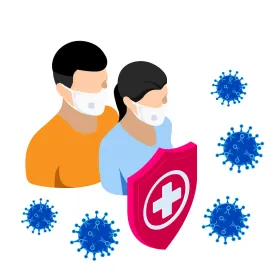Relief for borrowers of student loans owned by the U.S. Department of Education (eligible student loans) for a period of at least 60 days was previously announced by executive order on March 13, 2020. The Coronavirus Aid, Relief and Economic Security Act (CARES Act) replaced this executive order and expanded upon that relief to offer borrowers no interest and no payments on eligible student loans for a period of six months, among other benefits.
No Interest on Student Loans
Interest will be waived on all eligible student loans effective March 13, 2020 and continuing through September 30, 2020. The adjustment will be automatic; there is nothing borrowers need to do to have the interest waiver applied to their eligible federal loans.
Option to Stop Payment on Student Loans
In addition, payments on eligible student loans will be automatically paused through September 30, 2020; borrowers do not need to take any action to receive this benefit. There will be no penalties or late fees assessed. Because the relief is in the form of waiving interest rather than the federal government making loan payments for borrowers, borrowers will see no difference in their student loan balances between now and September 30, 2020 unless they choose to continue making payments. Any payments made on eligible student loans during this period will be applied to principal (after paying interest accrued prior to March 13, 2020).
Skipped Payments Counted Toward Forgiveness Programs
Borrowers on an income driven repayment plan may stop payments through September 30, 2020 and still have skipped payments count towards their 20 or 25 years (depending on the plan) of payments.
Similarly, borrowers who are pursuing Public Service Loan Forgiveness (PSLF) may stop payments through September 30, 2020 and still have skipped payments count toward the 120 monthly payments required. The status of this benefit, as it relates to borrowers who were pursuing PSLF but would currently otherwise be considered ineligible for the program due to reduced hours or a loss of qualifying employment, is in need of clarification. Importantly, the required 120 monthly payments need not be consecutive, so if further guidance shows that those pursuing PSLF but affected by job loss or reduced hours are not eligible to have skipped payments count towards PSLF, borrowers can still resume progress towards PSLF once qualifying full-time employment resumes.
Tax-Free Employer Contributions for Student Loans
Employers who pay student loans as an employee benefit may contribute up to $5,250 tax free for 2020.
Suspension of Student Loan Debt Collection
Debt collection on defaulted eligible student loans has been halted. Borrowers whose wages continued to be garnished after March 13, 2020 should contact their employer, and any funds received by the Department of Education in error will be returned to the borrower. Borrowers whose federal tax refunds were to be withheld due to defaulted federal student loan debt will have those refunds returned if the process for withholding the refund was not already completed prior to March 13, 2020. Similarly, borrowers who had a portion of their Social Security withheld to repay defaulted student loan debt will have that portion returned if the payment was in the process of being withheld on or after March 13, 2020.
Loans That Are Not Eligible
Note that some Perkins loans are held by educational institutions and some Federal Family Education Loan (FFEL) debts are owned by commercial lenders, and neither category of loans is eligible for the interest waiver at this time. While FFEL Program and federal Perkins loans that are not owned by the government can be consolidated into a Direct Consolidation Loan, which would be eligible, borrowers should be careful to note whether the interest rate after the zero percent interest waiver ends would be higher than what the borrower is currently paying. Consolidation also causes any outstanding interest to capitalize. Private loans are not eligible for these benefits.




 />i
/>i
